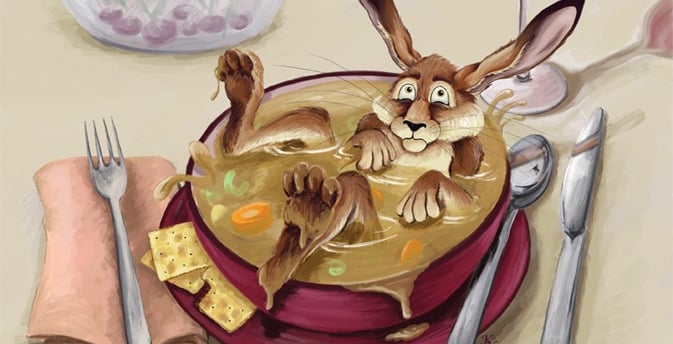C’è / Ci sono — How to Spot Hares (and More) in Your Italian Soup
Learn how to use “c’è” and “ci sono” naturally in Italian. A clear guide with fun examples — including one about soup! Perfect for Italian learners in The Hague.
LEVEL 1
Nicola Sorrenti
6/7/20252 min read


Why Do Italians Love “Ci”?
You’ll hear “ci” everywhere in Italian — and it can feel mysterious or confusing at first.
How can one tiny word have so many uses?
Today we’re focusing on one specific (and very useful) function: “ci” combined with the verb essere.
This structure helps you talk about what is present or exists — a super handy tool in everyday conversation.
And yes, we’ll do this using an example involving... hares in soup. Because why not?
Where Does “Ci” Come From?
According to Treccani, the particle “ci” has ancient roots:
It comes from the Latin “hic” / “hice”, originally used as a demonstrative pronoun meaning “here/there” or “this/that”.
In modern Italian, “ci” often signals location or existence — especially when used with the verb essere (“to be”).
Structure: “C’è” vs. “Ci Sono”
When combined with essere, “ci” helps express the presence of something —
just like saying there is / there are in English.
Formula:
Singular = C’è (ci + è)
Plural = Ci sono
C’è una lepre. → There is a hare.
Ci sono due lepri. → There are two hares.
Note on spelling:
C’è uses an apostrophe because “ci è” → contracts to “c’è” (to avoid awkward vowel clash).
Real-Life Example: Hares in Soup
Let’s set the scene:
You’re in Italy. It’s a charming evening. You find a cosy little trattoria and order a nice warm zuppa.
“Mi scusi, vorrei una zuppa. Grazie!”
After a few minutes, your soup arrives... but surprise! There’s a hare (una lepre) floating in it.
What should you say?
“Mi scusi, c’è una lepre nella mia zuppa.”
→ There is a hare in my soup.
But wait — now there are two hares!
When the waiter returns, things have somehow worsened — now there are two hares in your soup.
This calls for the plural:
“Mi scusi, ci sono due lepri nella mia zuppa.”
→ There are two hares in my soup.
C’è / Ci Sono in Everyday Italian
As you leave the restaurant — hungry but linguistically enriched — you walk the streets of the city. You spot:
“C’è una pizzeria aperta.” → There is a pizza place open.
“Ci sono molte persone felici.” → There are many happy people.
See? C’è / Ci sono is everywhere — and once you learn it, you’ll start hearing it constantly.
Learning Italian in The Hague?
If you’re learning Italian in The Hague / Den Haag, mastering little structures like c’è / ci sono will make your conversation flow naturally. These are the building blocks of everyday Italian!
👉 Book a free trial lesson — I offer fun, practical Italian lessons in The Hague to help you speak with confidence (and order soup without surprises).
